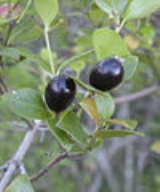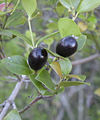
Carissa ovata
Encyclopedia
- "Currant Bush" redirects here. Not to be confused with Bush Currant (Miconia calvescens).
Carissa spinarum, the Conkerberry or Bush Plum, is a large shrub
Shrub
A shrub or bush is distinguished from a tree by its multiple stems and shorter height, usually under 5–6 m tall. A large number of plants may become either shrubs or trees, depending on the growing conditions they experience...
of the dogbane family
Family (biology)
In biological classification, family is* a taxonomic rank. Other well-known ranks are life, domain, kingdom, phylum, class, order, genus, and species, with family fitting between order and genus. As for the other well-known ranks, there is the option of an immediately lower rank, indicated by the...
(Apocynaceae
Apocynaceae
The Apocynaceae or dogbane family is a family of flowering plants that includes trees, shrubs, herbs, and lianas.Many species are tall trees found in tropical rainforests, and most are from the tropics and subtropics, but some grow in tropical dry, xeric environments. There are also perennial herbs...
), widely distributed in tropical regions around the Indian Ocean
Indian Ocean
The Indian Ocean is the third largest of the world's oceanic divisions, covering approximately 20% of the water on the Earth's surface. It is bounded on the north by the Indian Subcontinent and Arabian Peninsula ; on the west by eastern Africa; on the east by Indochina, the Sunda Islands, and...
. It is most well known in Australia
Australia
Australia , officially the Commonwealth of Australia, is a country in the Southern Hemisphere comprising the mainland of the Australian continent, the island of Tasmania, and numerous smaller islands in the Indian and Pacific Oceans. It is the world's sixth-largest country by total area...
, where it is also called Currant Bush or, more ambiguously, "native currant" or even "black currant". It is, however, neither closely related to plum
Plum
A plum or gage is a stone fruit tree in the genus Prunus, subgenus Prunus. The subgenus is distinguished from other subgenera in the shoots having a terminal bud and solitary side buds , the flowers in groups of one to five together on short stems, and the fruit having a groove running down one...
s (Prunus) nor to true currant
Ribes
Ribes is a genus of about 150 species of flowering plants native throughout the temperate regions of the Northern Hemisphere. It is usually treated as the only genus in the family Grossulariaceae. Seven subgenera are recognized....
s (Ribes), which belong to entirely different lineages of eudicots. In India
India
India , officially the Republic of India , is a country in South Asia. It is the seventh-largest country by geographical area, the second-most populous country with over 1.2 billion people, and the most populous democracy in the world...
, it is also called Wild Karanda, referring to the related Karanda
Karonda
Carissa carandas is a species of flowering shrub in the dogbane family, Apocynaceae. It produces berry-sized fruits that are commonly used as a condiment or additive to Indian pickles and spices. It is a very hardy, drought-tolerant plant that thrives well in a wide range of soils...
(C. carandas). C. spinarum is often discussed under its many junior synonyms (see below).

Ecology

Clay
Clay is a general term including many combinations of one or more clay minerals with traces of metal oxides and organic matter. Geologic clay deposits are mostly composed of phyllosilicate minerals containing variable amounts of water trapped in the mineral structure.- Formation :Clay minerals...
s and clay-loam
Loam
Loam is soil composed of sand, silt, and clay in relatively even concentration . Loam soils generally contain more nutrients and humus than sandy soils, have better infiltration and drainage than silty soils, and are easier to till than clay soils...
s; in more arid
Arid
A region is said to be arid when it is characterized by a severe lack of available water, to the extent of hindering or even preventing the growth and development of plant and animal life...
regions the plant tends to be confined to areas of higher moisture such as at the base of hills or floodout areas. But it has a high ecological tolerance and can live in a wide range of habitat
Habitat
* Habitat , a place where a species lives and grows*Human habitat, a place where humans live, work or play** Space habitat, a space station intended as a permanent settlement...
s. In Australia for example, it is often found in association with Eucalyptus brownii, Poplar Box (E. populnea), Gidgee
Acacia cambagei
Acacia cambagei, commonly known as Gidgee , Stinking wattle or Stinking gidgee is an endemic tree of Australia. It is found primarily in semi-arid and arid Queensland but extends into the Northern Territory, South Australia and north-western New South Wales. It can reach up to 12 meters in height...
(Acacia cambagei) or Brigalow (A. harpophylla), in coastal rainforest, gallery forest and vine thickets in regions receiving in excess of 900 mm annual rainfall, as well as softwood scrubs and open eucalypt
Eucalypt
Eucalypts are woody plants belonging to three closely related genera:Eucalyptus, Corymbia and Angophora.In 1995 new evidence, largely genetic, indicated that some prominent Eucalyptus species were actually more closely related to Angophora than to the other eucalypts; they were split off into the...
savannas receiving less than 700 mm annual rainfall.
Conkerberries are edible, but only when fully ripe; they have a sweet flavour, but the milky sap of this plant – and its unripe fruit – is poisonous, as typical for the Apocynaceae. They are a popular bush tucker food for Australian Aborigines
Australian Aborigines
Australian Aborigines , also called Aboriginal Australians, from the latin ab originem , are people who are indigenous to most of the Australian continentthat is, to mainland Australia and the island of Tasmania...
in Central Australia
Central Australia
Central Australia/Alice Springs Region is one of the five regions in the Northern Territory. The term Central Australia is used to describe an area centred on Alice Springs in Australia. It is sometimes referred to as Centralia; likewise the people of the area are sometimes called Centralians...
. The fruit is known as merne arrankweye in the Arrernte language, anwekety in Anmatyerr and nganango in Pintupi
Pintupi
Pintupi refers to an Australian Aboriginal group who are part of the Western Desert cultural group and whose homeland is in the area west of Lake MacDonald and Lake Mackay in Western Australia. These people moved into the Aboriginal communities of Papunya and Haasts Bluff in the west of the...
. The fruits are also a popular food for the Australian Bustard
Australian Bustard
The Australian Bustard, Ardeotis australis, is a large ground bird of grassland, woodland and open agricultural country across northern Australia and southern New Guinea. It is also commonly referred to in Central Australia as the Bush Turkey, particularly by Aboriginal people.The male is up to ...
, Emu
Emu
The Emu Dromaius novaehollandiae) is the largest bird native to Australia and the only extant member of the genus Dromaius. It is the second-largest extant bird in the world by height, after its ratite relative, the ostrich. There are three subspecies of Emus in Australia...
and many other birds in its range. Its leaves provide food for butterflies (e.g. Australian Crow
Euploea core
The Common Crow is a common butterfly found in South Asia. In India it is also sometimes referred to as the Common Indian Crow, and in Australia as the Australian Crow. It belongs to the Crows and Tigers subfamily of the Nymphalidae .The Common Crow is the most common representative of its genus...
, Euploea core) and moths (e.g. some hawkmoths)
C. spinarum is frequently a weed in grazing land in northern Australia, choking out grasses, reducing the ability of livestock to feed, interfering with stock handling and providing a refuge for vermin. The plant is capable of reproducing rapidly by layering
Layering
Layering is a means of plant propagation in which a portion of an aerial stem grows roots while still attached to the parent plant and then detaches as an independent plant. Layering has evolved as a common means of vegetative propagation of numerous species in natural environments...
and is difficult to control mechanically and expensive to manage with herbicides. On the other hand, it has been used in attempts to restore small-bird habitat in disturbed dry rainforest in Queensland, Australia.
Parts of the plant are used medicinally
Herbalism
Herbalism is a traditional medicinal or folk medicine practice based on the use of plants and plant extracts. Herbalism is also known as botanical medicine, medical herbalism, herbal medicine, herbology, herblore, and phytotherapy...
for joint and muscle pain by the Maasai people of Kenya
Kenya
Kenya , officially known as the Republic of Kenya, is a country in East Africa that lies on the equator, with the Indian Ocean to its south-east...
.
Synonyms
Well known for its fruit to locals and quite variable across its wide range and diverse habitat types, the Conkerberry has been described times and again by botanists under a number of names. Robert BrownRobert Brown (botanist)
Robert Brown was a Scottish botanist and palaeobotanist who made important contributions to botany largely through his pioneering use of the microscope...
alone described it no less than four times under different names, and R.H. Beddome
Richard Henry Beddome
Colonel Richard Henry Beddome was a British military officer in India, chief conservator of the Madras Forest Department and a naturalist...
not only described it twice as a "new species
Species
In biology, a species is one of the basic units of biological classification and a taxonomic rank. A species is often defined as a group of organisms capable of interbreeding and producing fertile offspring. While in many cases this definition is adequate, more precise or differing measures are...
" of Carissa
Carissa
Carissa is a genus of about 20-30 species of shrubs or small trees native to tropical and subtropical regions of Africa, Australia and Asia....
, but believed two other growth-forms
Morphology (biology)
In biology, morphology is a branch of bioscience dealing with the study of the form and structure of organisms and their specific structural features....
of it to be mere varieties of Karonda
Karonda
Carissa carandas is a species of flowering shrub in the dogbane family, Apocynaceae. It produces berry-sized fruits that are commonly used as a condiment or additive to Indian pickles and spices. It is a very hardy, drought-tolerant plant that thrives well in a wide range of soils...
(C. carandas). But in fact, C. spinarum was already named by Carl Linné in his 1771 Mantissa Plantarum, and thus all subsequent names are treated as junior synonyms.
The following list gives the now-invalid names under which the Conkerberry has been placed in Carissa. Apart from that, it has also been assigned, under various names, to Antura and Arduina (both now synonymized with Carissa), as well as Azima
Azima
Azima is a genus of plants in family Salvadoraceae.Species include:* Azima sarmentosa* Azima tetracantha...
, Cabucala, Chapelieria, Damnacanthus, Strychnos
Strychnos
Strychnos is a genus of flowering plants, belonging to family Loganiaceae . The genus includes about 190 species of trees and lianas, distributed around the world's tropics....
, and the now-invalid Carandas and Jasminonerium.


